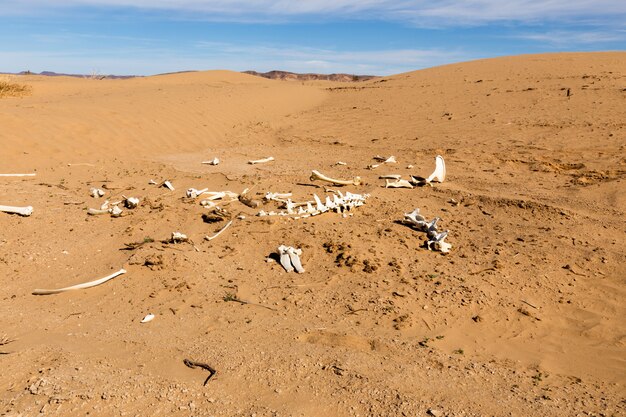Interesting Facts About the Gobi Desert

The Gobi Desert is the largest desert in Asia.
The Gobi Desert spans across parts of northern China and southern Mongolia.
The Gobi Desert is known for its extreme temperatures, ranging from scorching hot during the day to freezing cold at night.
Despite its arid conditions, the Gobi Desert is home to a diverse array of plant and animal species, including the elusive snow leopard.
The Gobi Desert is famous for its towering sand dunes, some reaching heights of over 300 meters.
The Gobi Desert is a crucial breeding ground for the endangered two-humped Bactrian camel.
The Gobi Desert is rich in dinosaur fossils, making it a haven for paleontologists.
The Gobi Desert experiences regular sandstorms, known locally as black storms, which can engulf the landscape for days.
The Gobi Desert has some of the clearest night skies, offering incredible stargazing opportunities.
The Gobi Desert is home to the world’s largest fossilized dinosaur eggs.
The Gobi Desert is so vast that it takes up nearly 30% of Mongolia’s land area.
The Gobi Desert is a challenging terrain for human survival, making it one of the most inhospitable places on Earth.
Despite its harsh conditions, there are several oases in the Gobi Desert that provide essential water sources for local communities.
The Gobi Desert served as a trade route along the ancient Silk Road.
The Gobi Desert has inspired many artists and writers, who find its barren beauty captivating.
Interesting Facts About the Gobi Desert part 2
The Gobi Desert is a popular destination for adventurers and desert explorers.
The Gobi Desert faces environmental challenges due to climate change and desertification.
The Gobi Desert is home to rare and unique flora species, specially adapted to survive in its extreme conditions.
The Gobi Desert is known for its stunning sunsets and sunrises, painting the vast desert in vibrant colors.
The Gobi Desert has been a source of inspiration for filmmakers, with several movies filmed in its dramatic landscapes.
The Gobi Desert is believed to have been inhabited by humans for over 30,000 years.
The Gobi Desert is home to several indigenous communities, who have adapted their lifestyle to its harsh conditions.
The Gobi Desert is a treasure trove for geologists, offering insights into the Earth’s geological history.
The Gobi Desert is a paradise for birdwatchers, with over 400 species of birds recorded in the region.
The Gobi Desert’s shifting sand dunes create a dynamic landscape, constantly changing with the wind.
The Gobi Desert is home to the Mongolian wild ass, also known as the khulan or dziggetai.
The Gobi Desert has inspired many legends and myths among the local communities.
The Gobi Desert’s remoteness and untouched beauty make it a prime location for eco-tourism.
The Gobi Desert’s sand is not only golden but also known for its unique granule shape.
The Gobi Desert’s vast expanse makes it a perfect place for outdoor activities such as dune bashing and camel trekking.
The Gobi Desert is rich in mineral resources, including coal, copper, and gold.
The Gobi Desert is a paradise for paleontologists as it preserves fossilized remains in exceptional condition.
The Gobi Desert is home to the world’s longest temperature record station, providing valuable climate data.
The Gobi Desert’s extreme temperature range poses a challenge for any living creature surviving in the region.
The Gobi Desert’s sparse vegetation has evolved unique adaptations to conserve water.
The Gobi Desert’s vastness and isolation create an unmatched sense of solitude and tranquility.
The Gobi Desert’s shifting sands create intricate patterns that are a delight for photographers.
The Gobi Desert’s sandstorms can reach speeds of up to 100 km/h, making them a force to be reckoned with.
The Gobi Desert’s dry climate makes it an ideal location for telescope observations with minimal atmospheric interference.
The Gobi Desert’s harsh conditions have shaped the nomadic lifestyle of the local communities, relying on their herds for survival.
The Gobi Desert’s unique ecosystem is under threat due to overgrazing and unsustainable mining practices.
The Gobi Desert’s vast stretches of emptiness create a profound sense of awe and insignificance.
The Gobi Desert’s ancient rock formations tell a story of geological evolution spanning millions of years.
The Gobi Desert’s sand dunes are a playground for adventure enthusiasts, offering opportunities for sandboarding and quad biking.
The Gobi Desert’s expansive landscapes are a source of inspiration for artists, writers, and photographers seeking solitude and natural beauty.

